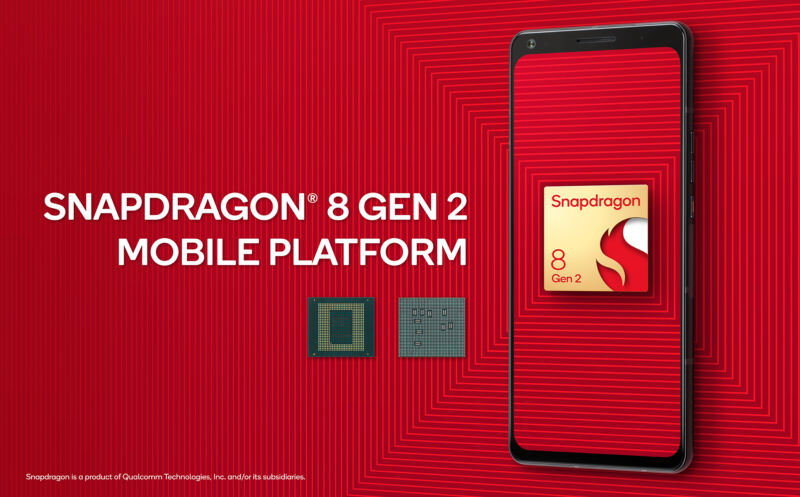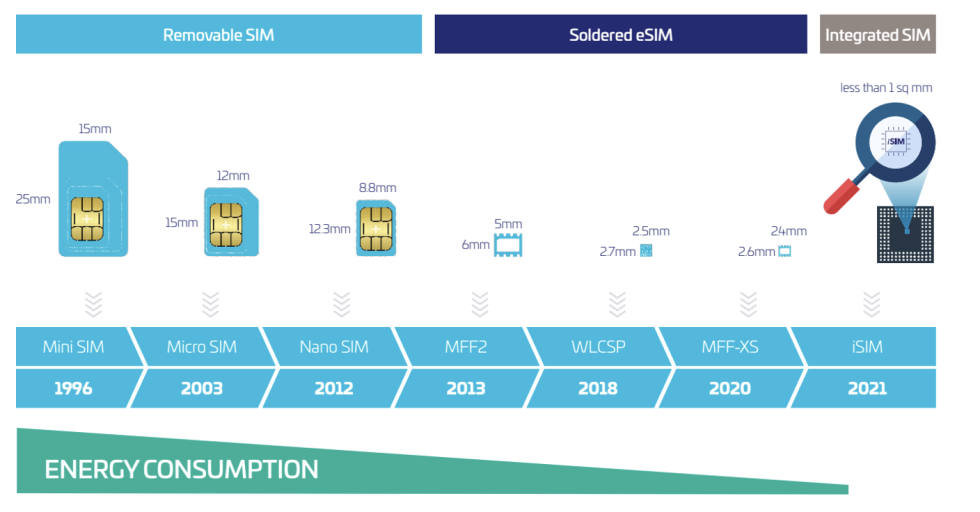
Qualcomm
Here's an interesting bit of news out of Mobile World Congress: Qualcomm says the Snapdragon 8 Gen 2 has been certified as the "world’s first commercially deployable iSIM (Integrated SIM)." What the heck is an iSIM? Didn't we just go through a SIM card transition with eSIM? We did, but iSIM is better than eSIM. We'll explain, but the short answer is that iSIM is the next step in the continual march to reduce the size of SIM cards.
OK, so SIM cards are (in the smallest "nano" size) little 12×9 mm plastic cards that you physically stick into your phone. SIM stands for "Subscriber Identity Module," and these cards mostly just identify you to your cell carrier, allowing your device to be provisioned for the cellular service that you pay a monthly bill for. The idea is that if you buy a new phone, or have multiple phones, you can just move the SIM card over, and—if there aren't any compatibility problems—your service could be easily moved between phones.
In ye olden days, these cards would store some actual data like contacts and messages, but with the advent of smartphones, all of that moved to the cloud. Today a SIM card can store up to 265KB of data in that 12×9 mm card, which is absolutely horrible data density considering similarly sized MicroSD cards can go up to 1TB, or about 4.2 million times more data. SIM cards are a huge waste of space in an industry that is very aggressive about saving space, so they needed to go.
Enter eSIMs, the newish standard that does away with the physical, removable SIM card and instead solders a tiny chip on the motherboard of your phone. These came to the Google Pixel line in 2017, the iPhone in 2018, and some Samsung phones in 2021, and, for a few models, they lived alongside physical cards. A major turning point for most carriers was Apple killing the physical SIM card in 2022 with some iPhone 14 models and going eSIM-only. An eSIM-only device has no removable card at all, and therefore no card slot, simplifying device design, saving space, and removing one possible spot for water ingress. Instead of sticking a hunk of plastic in the phone, you provision your device via some app, usually by signing in to your account with your carrier. eSIMs are a big size savings over physical cards, and the smallest chips are around 2.5×2.3 mm.

Enlarge / Qualcomm is doing this iSIM project with the tech company Thales, and they made this lovely graphic.
eSIMs are still a chip taking up space on your motherboard, and that's not ideal if you want to squeeze every square millimeter of space out of a phone. The next shrinking step is iSIM—an Integrated Subscriber Identity Module. Rather than a chip on the motherboard, iSIMs are integrated directly onto the SoC. SoC (system on a chip) integration is the technology that makes smartphones possible. Instead of a thousand little chips for things like the CPU, GPU, RAM, modem, and a bunch of other things, everything gets packed into one single do-everything piece of silicon. Individual chips require more space and power thanks to having to make motherboard traces to connect everything and having to deal with chip packages.
Building everything in one chip, with the tiniest transistors you can muster, is the cheapest and most space-efficient and power-efficient way to do things, and now SIM cards are going to disappear into that big block of stuff. iSIMs will be measured in fractions of a millimeter, and as part of the SoC, they will continually shrink every year as chip process nodes hit ever-smaller nm measurements. It sounds like this is the endgame for SIM technology, and besides helping out phones, will be great for evermore space-constrained devices like smartwatches.
Of course, we'll need carriers to be on board with this, and that's what Qualcomm's announcement is mostly about. The iSIM solution in the Snapdragon 8 Gen 2 SoC—which is shipping now—has been certified by the GSMA, aka the world's cell carriers. Qualcomm says "the new iSIM is fully compliant with the GSMA Remote SIM Provisioning standard; meaning its subscriptions are remotely manageable through any standard platforms." That's the same standard as eSIM, and it's held to all the same security requirements, so theoretically, any carrier that works with eSIM shouldn't see a difference between an eSIM and an iSIM. iSIM is still just a hunk of silicon that needs software provisioning—where the silicon lives shouldn't really matter to your carrier.
Like many Qualcomm SoC components, using iSIM is optional even though it's built into the chip. All current Snapdragon 8 Gen 2 phones use discrete eSIM chips instead of iSIM. Now that the solution is certified, the wait is on for some phone manufacturer to build iSIM into its next product design.
from Hacker News https://ift.tt/noM1Bus
No comments:
Post a Comment
Note: Only a member of this blog may post a comment.